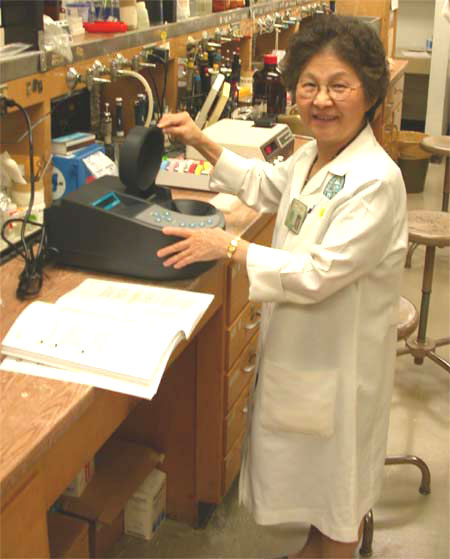
University of Oklahoma, 1966
 Su-Chen Li, Ph.D.
University of Oklahoma, 1966 Research Professor of Biochemistry
Inborn Errors of Glycoconjugate
Catabolism
|
Dr. Su-Chen Li and her husband, Dr.
Yu-Teh Li, have been working as a team in the field of glycobiology
for over three decades. The two major research projects in Drs. Li's lab
are: (i) biochemical studies of inborn lysosomal diseases, and
(ii) studies of biomedically useful glycosidases. S.-C. Li is in
charge of Project (i) and Y.-T. Li is responsible for Project (ii). Through the studies of the catabolism of glycoconjugates, Drs. Li have
contributed substantially to the basic understanding of the biochemical
basis of Fabry's disease and Tay-Sachs disease. Their laboratory was the
first to correctly establish the structure of the glycosphingolipid that
accumulates in the kidney of patients with Fabry's disease [J. Biol.
Chem. (1971) 246: 3769]. In 1973, they discovered that the catabolism
of Tay-Sachs ganglioside (GM2) requires a protein cofactor in addition
to the enzyme (beta-hexosaminidase A) [J. Biol. Chem. (1973) 248:
7512]. Subsequently, type AB Tay-Sachs disease was established to be the
deficiency of this protein cofactor. They have successfully cloned the
gene and overexpressed this gene in E. coli to produce the recombinant
activator protein [J. Biol. Chem. (1994) 269: 16276]. The crystal
structure of this activator protein was solved in collaboration with Dr.
C. S. Wright of the University of Virginia. Drs. Li have also found that the catabolism of GM2 in man is different
from that of mouse [J. Biol. Chem. (1998) 273: 66]. Their results
provided an explanation on why the Hex A-knock out mice (the murine model
for type B Tay-Sachs disease) does not resemble the disease in man. They
have also deciphered the nucleotide sequence of the activator protein
gene that is responsible for expressing the different specificity of the
protein cofactors in man and mouse [J. Biol. Chem. (1999) 274:
28612]. Their work has been continuously supported by the NIH since 1971. |